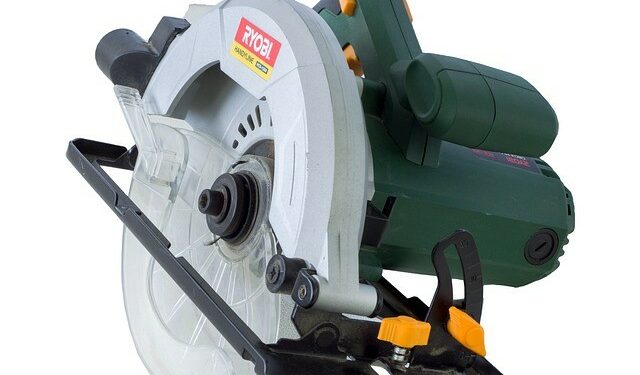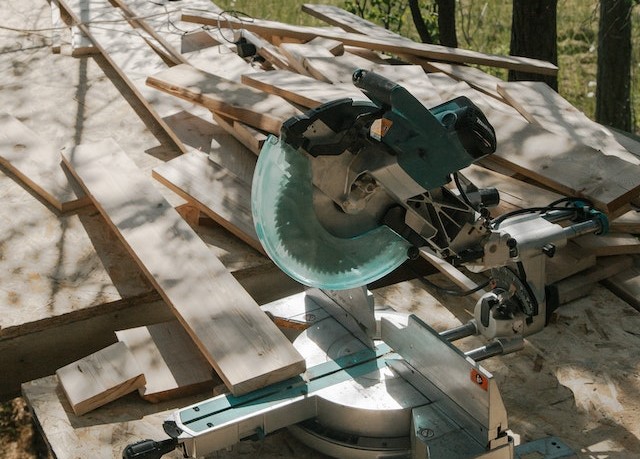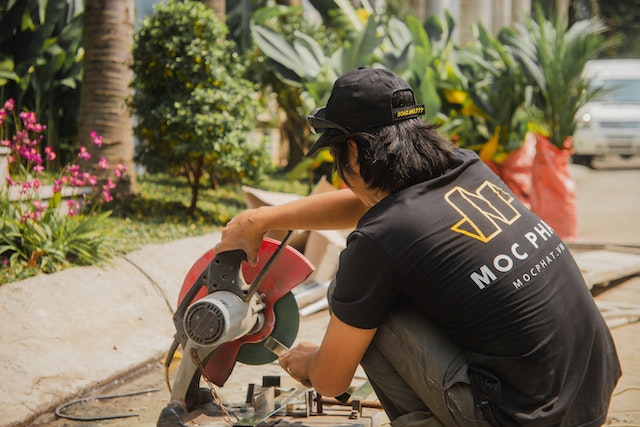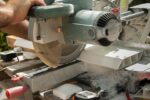How to Cut a Straight Line with a Circular Saw

Circular saws are a popular and versatile tool in woodworking, but making straight cuts can be a daunting task for beginners. A wobbly cut can ruin a project and waste materials, so it’s essential to learn how to cut straight lines with a circular saw.
In this article, we’ll provide step-by-step instructions on how to cut a straight line with a circular saw, as well as share some helpful tips to make the process easier and safer. Whether you’re a seasoned woodworker or a novice, these tips will help you achieve precision and confidence with your circular saw.
Safety First
Ah yes, and today we’re gonna talk about the first thing in any woodwork project: safety. Before you even consider speedily cutting a straight line with a circular saw, you’d do well to make sure your safety is number one!
First and foremost, make sure your circular saw is unplugged before you get started. I mean, why push fate? Circular saws are powerful tools and sometimes have a mind of their own. Don’t let it be your downfall!
Secondly, don’t forget your safety gear. Protective glasses, hearing protection, and gloves should be among the items in your project arsenal. If you’re thinking about not wearing them, think again. No one wants their project to have a tragedy that could’ve been prevented.
Now while we’re on the subject of safety, let’s make sure that your circular saw blade is fully secured in its place. You don’t want any embarrassing mishaps in the middle of your cut. Also, be sure your circular saw is adjusted to an appropriate level – what’s the use in having a super powerful saw that is set to minimum output?
Last but not least, make sure the area you’re working in is well-lit. You don’t want to be caught in the dark, your project ruined and you in danger! So there you have it folks, I’ve made sure you’re well equipped with safety information to make sure your cut is a piece of cake. So be safe and have fun!
Make Sure Circular Saw is Unplugged
Alright folks, listen up! Before you start any manual sawing business, you’ve gotta make sure that your saw is unplugged. Yeah, you heard me right. Make sure that you unplug it before you get ready to cut. It’s really important and might save your life.
Now it’s fine if you forget to unplug it, and you can still finish your job, but pretend like you haven’t heard me say that, okay? It’s for your own safety.
So, unplugging will save you from any potential electrocution, so I strongly suggest you get into the routine of double-checking at least twice before starting your job.
So, how do you know your saw is unplugged correctly? Well, take a look at the power cord and then try to pull it. If the extension cord and plug are still connected to the saw, then it’s still plugged in.
If you do manage to unplug your saw, don’t stop there. Make sure you also check that the safety switch isn’t left in the ‘on’ position. This is to make sure that the moment you plug it back in, you won’t accidentally turn it on and injure yourself. So, just for good measure, check it twice.
And that’s all you gotta know about unplugging the saw! Remember, it doesn’t hurt to double-check just to be extra sure. That’s why I’m still here, haha.
Wear Safety Gear

Before you even think to pick up that circular saw, make sure you’ve properly geared up. This is an important step to ensure your safety. In fact, it’s safety first, which I think is really important, especially when using tools.
Put on your safety glasses, oil filter mask and noise-cancelling ear protectors first. Then make sure you have the proper clothing for the task at hand. No, that doesn’t mean a t-shirt with a funny slogan, that’s actually really dangerous. You want clothes that are thick enough to protect you from any accidental sawdust and other debris that might fly in the air, so get something much thicker like a long sleeve button down shirt, preferably denim. Throw on a pair of jeans as well and make sure it has enough pockets so you can store some screws, nails and other stuff while you’re working.
Finally, make sure you put on a pair of proper work boots. These will protect your feet from the sharp pieces of wood that might accidentally come your way. Plus, a good pair of work boots allow you to secure yourself firmly while working, which you’ll need in order to stay balanced while cutting.
Bump up the safety factor even further by wearing snug-fitting work gloves. They should offer enough protection that you don’t need to worry about accidentally being cut or burnt while operating the saw.
All in all, you need to be responsibly prepared with the proper protective gear before you even think about cutting with the circular saw. Make sure you have all the needed safety gear, and you’ll be good to go!
Preparing the Circular Saw Blade
Hey, we’re gonna start preparing the circular saw blade now, so I want you to pay attention and follow my instructions closely. First things first, make sure the blade is fully secured before you start sawing anything. You don’t want your blade flying off here and there while you’re trying to make a cut. That would be disastrous, not to mention down right dangerous. You also want to make sure the circular saw is adjusted to an appropriate level. You don’t want to be sawing away with a blade that’s too low or too high. That would mean your cuts might not be even, so you need to make sure the saw is calibrated and locked in the appropriate position.
Now, before you put the saw to the wood, take your time to double check the setup. Make sure the saw is secured and adjusted properly because if it’s not, you might end up tagging your wall with a nasty circular saw mark. Oh, and you don’t want that. That’s why when it comes to circular saws, you always want to take your time to get the blade ready
And that’s it for preparing the circular saw blade. Now, the next step is to actually make the cut. So, let’s get over to that now.
Make Sure the Circular Saw Blade is Fully Secured
Heyo there folks! So, it’s time to move onto the next step in cutting a straight line with a circular saw – which is to make absolutely sure that your saw blade is fully secured. Now, just how do you do that?
Well, first things first. Before you get started, make sure you disconned the power cord. We don’t want any accidents! After that, your next task is to check out the blade, and make sure it’s affixed properly. This is typically done by tightening the screw at the center of the blade. It’s important to give it a good turn so it’s securely in place and won’t slip around.
You’ll also need to check another part of the saw – the arbor nut. This locks the blade in place and sets the depth of your cut. If you don’t have the arbor nut secured, the blade will wobble when you start cutting, so it’s really important you get that done before moving on.
As for the last part of ensuring the saw blade is secured, all you have to do is make sure that the blade guard opens and closes smoothly. If it’s not working, don’t just try to cram it. You don’t want it getting stuck as that could cause all sorts of issues down the road.
And there you have it folks – that’s how you make sure the saw blade is fully secured. Now, I know all this sounds complicated, but I promise, once you get the hang of it, it’s all cake! Now, let’s move on to the next part and make some magical straight lines!”
Make Sure the Circular Saw Is Adjusted to an Appropriate Level
Let’s step back, take a deep breath, and talk about why it’s so important to get the circular saw adjusted to the proper level.
It’s like this, imagine you’re playing a game of basketball and you’ve been asked to shoot a 3-pointer. Now, the hoop you’re shooting at is about 8-feet high, but you’re 5’6” tall, so if you just shoot the ball straight up it ain’t gonna make it in.
So, being the savvy player that you are, you decide to raise the hoop to 6-feet high, that way you can easily make the shot, right?
Well, that’s pretty much the same thing when it comes to adjusting your circular saw. The cut line on whatever you’re cutting may not be level, which means you’ll need to adjust the saw in order to hit the mark.
So, you’re gonna want to make sure that the saw is properly adjusted to an appropriate angle for your cut. This is important for a few reasons, the first being that you don’t wanna end up with an uneven cut that’s crooked. Secondly, it could be dangerous if the saw isn’t adjusted properly as it could go off track and create an unpredictable cutting situation.
Anyway, to adjust your saw, you need to make sure that the blade is parallel to the cut that you’re making. To do this, you’ll want to tilt the blade downward and cover the blade with the handle of your tape measure. Then use a straight edge along with the handle of the tape measure to ensure that the blade is on the same level as the straight edge.
Once you’ve adjusted the blade and it’s at the right angle, then you’ll be ready to make your cut. So, keep in mind that it’s always better to take your time and measure twice before you start cutting. You don’t want to spend all your time redoing a cut that could have been avoided if you just took the time and gotten your saw adjusted correctly in the first place.
Making a Straight Cut

Hey there, let’s get cutting! You got your circular saw, your safety gear, and the blade is all set. Let’s make that straight line!
Before we do, we need to measure our cut and then draw a straight line with a pencil or a ruler. Make sure the line is even with whatever you’re cutting.
Now, let’s place that circular saw on the line. Now be careful here, make sure you’re handling the saw with care – you don’t want it to just slip off! Take your time placing it, making sure it is aligned so that the blade of the saw is even with the line.
Once the saw is in place, make sure you secure it so that it doesn’t slide away. Then plug it in and press the on button, keeping the blade evenly on the line. If you’re feeling confident, give it some more power and speed up the cut.
Now comes the important part – you have to be really careful if you want to make a true straight line. Keep your eyes on the blade, make sure it stays on the line. If it veers off the line, then stop the saw and adjust it back before continuing.
When it’s done, hit that off button and unplug it. Congratulations, you’ve made the cut! If you need to, get out the sandpaper and smooth out the edges. And once you’re done, double check everything to make sure the cut is even, true, and straight.
See, that wasn’t so hard was it? Now you can make perfect straight lines with your circular saw and impress everyone with your sawing skills!
Measure Your Cut
When it comes to measuring your cut for a straight line with a circular saw, it’s important to get it right the first time. After all, you don’t want to waste time, money, or wood by having to make more than one cut. To measure your cut, you need to know exactly what it is that you want your cut to achieve. Are you cutting boards for a fence in the backyard? Are you cutting a piece of plywood for a new bookshelf? Whatever it is you need to measure for, you need to make sure you have the correct measurements in hand.
If you’re a bit of a novice when it comes to cutting a straight line, don’t worry! There are plenty of helpful online videos and articles that will help you get your measurements right down to an exact science. One thing you want to make sure is that you measure twice, cut once. This handy proverb will save you from making any accidental mistakes that’ll leave you to start over with a new piece of wood.
Another helpful suggestion is to use a straightedge when taking your measurements. This will prevent any inaccurate measurements and will have you ready to begin your cut when you’re done. If you have access to a power saw, it may come with a laser guide to help you get your precise measurements even easier.
Once you have your measurements all set, you can feel confident that when you place your circular saw blade on the line, you will get the precise and straight cut that you need. Good luck, and remember that measuring your cut is the most important part of this project. Don’t skimp out on this step!
Draw a Straight Line
Ah yes, now that you’ve measured your cut, it’s time to draw your straight line. The easiest way do this is with a good ol’ fashioned pencil and ruler. However, if you’re feeling adventurous you can use a laser line level.
Trust me, this will make your job much easier when it comes to cutting your line. Just make sure to adjust the setting on your device to make sure the line is level. Once you’ve done that, simply place it on the wood, turn it on, and away you go.
For those who don’t want to spend the extra money, a good old fashioned ruler and accountant-style pencil will do just fine. If you want to be extra careful you can also use two rulers to draw the straight line. Place one ruler on the line you measured, and another ruler on top of it. Then use the pencil to trace a line.
If you’re a bit of a maverick, an even easier way to draw a straight line is by using a chalk line. Just make sure to not get any dirt or dust from the chalk line on the wood, otherwise your lines won’t be true.
Whichever technique you decide to use, just make sure you take your time and don’t rush. After all, a good straight line is the secret to getting the perfect cut. Good luck out there!
Place Your Circular Saw on the Line

So you’ve made it to the exciting part of cutting with a circular saw! Before you turn it on and get started, you need to make sure you’ve placed your saw correctly.
It’s a pivotal moment here, so I suggest donning a comically-sized hardhat, sticking your tongue out, and telling yourself ‘It’s time to cut some wood!’
First off, take a deep breath and let go of any silly notions of cutting a perfect straight line on your first try. Sure, it might look jagged and wobbly if you don’t get it right, but don’t worry, more wood is always available to practice with later!
Now it’s time to place your circular saw onto the line. First, make sure the blade is lined up with the line you intend to cut. You want the blade to be lined up as accurately as possible. This might require patience and a steady hand. Trust me, it’s worth it in the end.
Once the blade is exactly where you want it, press down on the saw, locking it into position. You don’t want it to move when you start the saw, or your cut won’t be straight. Again, be patient and take your time with this step. It’s a crucial part of the process.
If you’re feeling confident, and you’ve got everything lined up properly, you can now turn on the saw and get started making that cut you planned.
But hold it, not so fast! Make sure you double check the saw is in the right position and that the blade is lined up with the line you drew. Once you can confirm this, you can start cutting and make that perfect straight line with a circular saw!
Secure the Saw in Place and Turn It On, Keeping the Blade Evenly on the Line
Alright folks, I’m moving on to the fun part – turning your circular saw on and getting it ready to cut that line. Alright, this one requires a bit of precision, so you’ve got to pay attention. First and foremost, make sure you’ve got your circular saw blade is on and secured. Next, you’ll need to make sure the saw is adjusted to an appropriate level.
Now, once it’s all set, take a deep breath because it’s time to place the saw blade onto the line. Now before doing that, I highly recommend that you measure your cut and draw a straight line. You don’t want to make any mistakes here.
Once you’ve got the right line all set, you need to take your saw and place the blade evenly on top of it. You don’t want it to be off, that’s just going to make all your hard work a waste. So make sure it’s all good there before turning the saw on.
Before you do that, you’ll also want to secure the saw in place. Most circular saws come with a convenient handle that helps you maneuver the blade and keep it from shifting during the cut. Now, one more time just to be sure, once it’s properly secured and sitting nice and snug take a few more seconds and double check that the saw is aligned with the line.
Once you’ve done all that successfully, you can turn the saw on. Now, the key here is to keep the blade evenly on the line. That’s the only way you’ll get a nice clean cut. Once the cut is complete, you can turn the saw off.
And that’s it folks, we’re all done here. Now all you have to do is check to make sure the cut is even and true, and if you’d like, you can even use some sandpaper to smooth out the edges. Congratulations, and happy sawing!
Finishing the Cut

Ah, the sweet sound of silence as the saw blade stops spinning! That’s it – you’re done making your straight cut!
Now, let’s move on to the mop-up phase – finishing the cut. To make sure your work looks perfect, follow these steps:
First off, make sure you turn off the saw. I know it’s tempting to leave it running for a few seconds after you’ve finished, just for the sweet sound it makes. But the last thing you want is for the blade to accidently keep on going and mess up your beautiful straight line.
Once you turn off the saw, it’s time to move on to the finishing touches. Take a piece of sandpaper and smooth out the edges of your wood, if needed. This will help to ensure your cut is as precise as possible.
The last step before you’re completely done is to double check the cut. This is crucial. Get an eagle eye and inspect it thoroughly. Make sure both sides are even, it’s perfectly straight, and that it looks perfect.
And that’s it! You’ve successfully cut a straight line with your circular saw. Just make sure to take your time, practice lots, and double check your work, and you’ll have no problems making clean, straight cuts.
Turn Off the Saw When the Cut is Complete
Well guess what, folks? It’s time to get to the really serious stuff. That’s right. Turning off the saw when the cut is complete. It’s actually critical because you don’t want to end up with a wobbly results due to the saw engine still running and the wayward blade wobbling around the wood. So how do you do this? It’s actually quite simple.
First thing, you must make sure the depth setting was spot on, meaning, the blade had to reach the other side and that’s all. After that, you just let go of the trigger and then let all of your worries wash away. Now you can breathe and admire your work before you move onto the next step.
Just make sure you don’t forget to turn off the saw because that could be a bit of disaster, man. You don’t want the blade still spinning when you try to take it off the wood. Talk about a mess! Not only that, it could be quite dangerous if you don’t know what you’re doing. Most likely you will end up with a few sawdust related accidents and nobody likes that, do they?
So pay attention when you turn off your saw because you know, this is serious business. We have to make sure the job gets done with no problems. After all, we have to remember why we are here in the first place, to cut a straight line with our saw! So, turn off your saw after the cut is complete and you’ll be sure that your project is in good hands and without any issues. Who knows, you might even get a round of applause from the crowd and that’s something we all want, isn’t it? So go ahead and get to work. It’ll be worth it in the end, trust me!
Use Sandpaper to Smooth Out the Edges, If Needed
All right people, now let’s talk about sandpaper. Now you’re probably asking, why do I need to use sandpaper if I used a circular saw? And the truth is, a lot of times when people are making a cut, it’s not always perfectly straight. If you want it to look nice and neat and professional, you’ll need to do the extra work and make sure the edges are smooth and even.
So what kind of sandpaper should you use? Well, it depends on how thick your material is, and whether you are working with softwood or hardwood. If it’s softwood, then you will want to choose a medium-grit or extra fine-grit sandpaper, and for hardwood, you want to go for a coarse-grit or extra coarse-grit sandpaper.
Before you begin working on your project, take a few minutes to do some sanding. Start with the coarser sandpaper and work your way up to the finer grits. This will make sure the edges are nice and smooth and won’t leave any deep ragged marks that would ruin the look of your work.
When you have finished sanding, use a shop cloth to wipe down the edges and make sure there are no rough bits that you may have missed. Once you have done this, give your masterpiece a final once over with a soft cloth. This will help to bring out the shine and make sure everything looks perfect.
So there you have it: sandpaper is a crucial step in your cutting process if you want the job to look right. Whether you are working with a circular saw or a miter saw, sandpaper is the key to a professional finish. And remember, when in doubt, sandpaper it out!
Double Check to Make Sure the Cut Is Even, True, and Straight.
Ha, yo! Well here we are at the end of the line. The final phase of the cutting adventure. You’ve come so far, you’ve handled a saw and learned about what it takes to make a smooth straight cut with your tools and it’s all led up to this moment. You’ve already done the big parts, the saw is off and it’s unplugged and you’ve made the cut. But you ain’t done yet buddy! Because it’s all worthless if you don’t make sure that your cut is on point!
You need to take a look at your masterpiece and make sure it’s smooth, even, and straight. No jagged edges or funny business allowed! Before you start working with your newly cut piece it’s important to double check your work. Make sure the angle is on point, that the length is dead-on, and that the sides are even. Any mistakes here and your final product won’t look quite like what you were expecting!
A tip from my end is to use a combination square or a hand level or your eye to check for evenness. Hold the combination square up vertically on the edge of your cut, does it match? If it does, great. You know you cut it correctly. If it doesn’t match there you may have to do a little bit of sanding or remeasuring. But if you really did your homework before you started cutting, you shouldn’t need to do this.
It’s easy to feel discouraged when you’ve put in so much work and then you find out you got it wrong. But don’t worry, mistakes happen, and if you need to adjust take that as a learning opportunity. As long as you can get the cut even, true, and straight you’ll be happy with the end product.
So, just remember, don’t forget to check your work and triple check it if you can. That way you don’t have to put in the time and energy for a do over. You got what it takes and I know your cut will turn out great!






